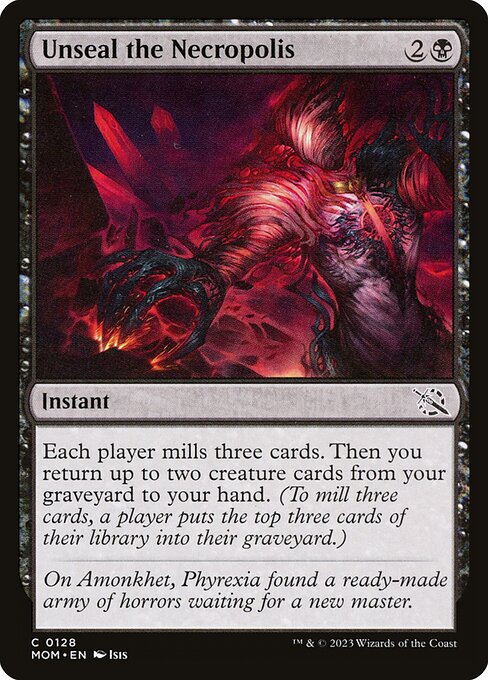
Image courtesy of Scryfall.com
Bridging cardboard and code: translating Unseal the Necropolis into a digital design language
Designing for MTG’s physical cards is only half the battle—digital representation amplifies the need for clarity, speed, and a touch of personality. When you bring a card like Unseal the Necropolis into the digital realm, the challenge isn’t just to copy-paste the rules text; it’s to translate intent, tone, and strategy into a UI that players can read and react to in a heartbeat 🧙♂️. This particular instant from March of the Machine, a black mana-backed spell with a three-card milling engine and a graveyard-recovery clause, becomes a compelling case study in how to respect the card’s design DNA while making it approachable on screens of all sizes 🔥.
Reading the rules at a glance: why readability matters for milling and graveyard interaction
Unseal the Necropolis costs {2}{B} and clocks in at a clean CMC of 3. In gameplay terms, it doesn’t threaten the battlefield with a big impact—its value lies in tempo and resource shaping: every player mills three cards, then the caster recovers up to two creatures from their own graveyard. Translating that into digital requires precise, scannable typography and intuitive zoning. The UI must clearly distinguish the global mill effect from the targeted graveyard-retrieval clause, ensuring players instantly grasp who is milling whom and what can be returned. In practice, this means distinct instruction blocks, generous line spacing for the two sentences, and a dedicated “Graveyard” area that visually confirms which creatures are eligible for return. The card’s black mana identity and common rarity call for a noir-inspired, legible frame that remains accessible to players who may be scanning a crowded match state during a late-night ladder session 🎲.
The rules text itself is concise, but its implications are broad: mill three cards can brick someone’s plan, push a graveyard strategy over the line, or simply fuel a table-wide tempo swing. In digital, we balance that by showing a succinct summary beneath the card image (e.g., “Each player mills three” with a separate line for the return condition) and offering a hover/tooltip that reveals deeper rulings when requested. This keeps the core text clean while still honoring the card’s depth for curious players who want to study the mechanics more closely 🧠.
Rule clarity in digital space is a design feature, not just a constraint. When a mill-heavy strategy appears, the UI should invite players to consider future draws, graveyard synergy, and potential recurrences—without forcing a pause to decode wall-of-text lawyering. Smooth, readable typography and predictable layout patterns reduce cognitive load and keep the focus on strategy and fun. ⚔️
Flavor, art, and the digital canvas: keeping Isis’s vision alive in a new medium
The art by Isis—a moody, evocative piece from March of the Machine—carries Phyrexia’s ominous march into Amonkhet’s mythic memory. When adapting this card for digital formats, designers lean into the stark contrast and the sense of inevitability that the artwork communicates. The digital presentation can honor the flavor text, “On Amonkhet, Phyrexia found a ready-made army of horrors waiting for a new master.”, by anchoring the card in a dark, cinematic palette while ensuring the text remains crisp enough to read in on-the-go sessions. In a UI, the image remains a strong focal point, with a controlled zoom and image-loading behavior that preserves the authenticity of the original illustration while optimizing for fast, responsive loading. It’s a dance between fidelity and practicality—preserving the atmosphere of the card and the broader MOM set’s story while making it feel at home on a phone, tablet, or desktop 💎🎨.
From a lore perspective, Unseal the Necropolis sits at an intersection of mill strategy and graveyard reclamation—two motifs that translate beautifully into digital deck-building tools. Players who enjoy building around disruption and resource reuse will appreciate not only the formal text but also the surrounding ecosystem: how other black cards in MOM interact with the graveyard, how milling can be weaponized or mitigated, and how the set’s flavor ties into a broader Phyrexian invasion narrative. In digital form, these connections become clickable, with quick reference links to related cards and EDH-compliant ideas for casual players, all while preserving the tactile memory of flicking through a physical set with friends 🏹🔥.
Design decisions: typography, color, and the user flow for a familiar yet fresh experience
A card like Unseal the Necropolis benefits from a consistent design language across platforms. The digital version must honor the color identity (black), the instant speed, and the sense of immediacy that comes with milling as a strategic tool. Designers pay particular attention to the “three cards” milling effect, ensuring it’s visible early in the text and that the graveyard-return option is not buried beneath secondary rules. The return clause, “up to two creature cards from your graveyard to your hand,” invites a secondary action—players may choose to retreive two big finishers or just one utility critter—so the UI often offers a contextual menu next to the graveyard zone to select eligible targets. A readable font, adequate line height, and localized spacing help players quickly parse the decision tree, even when a match is spinning with multiple triggers and other players’ actions 🧭.
Collectors and competitive players alike will notice that the MOM set keeps the card within standard play but leans into modern interactive flavor. The rarity is common, which in physical products means wider print runs and more diverse reprint potential; in digital, it translates to accessible play experiences that don’t rely on scarce card stock for competition. The dual availability of foil and nonfoil in physical prints mirrors the digital emphasis on clarity and speed—foil shines in a well-lit arena, while nonfoil keeps text legible at 100% clarity during a long night of drafting with friends ⚔️.
Phone Stand Travel Desk Decor for SmartphonesMore from our network
- https://crypto-acolytes.xyz/blog/post/when-arcades-shaped-tomorrows-tech-landscape/
- https://blog.digital-vault.xyz/blog/post/mtg-wavesifter-market-signals-price-trends-ahead-of-reprint-cycles/
- https://blog.digital-vault.xyz/blog/post/designing-a-cohesive-visual-identity-for-digital-products/
- https://blog.digital-vault.xyz/blog/post/streamline-content-repurposing-with-smart-workflow-automation/
- https://blog.digital-vault.xyz/blog/post/morgue-theft-inside-mtg-lore-communities-online/